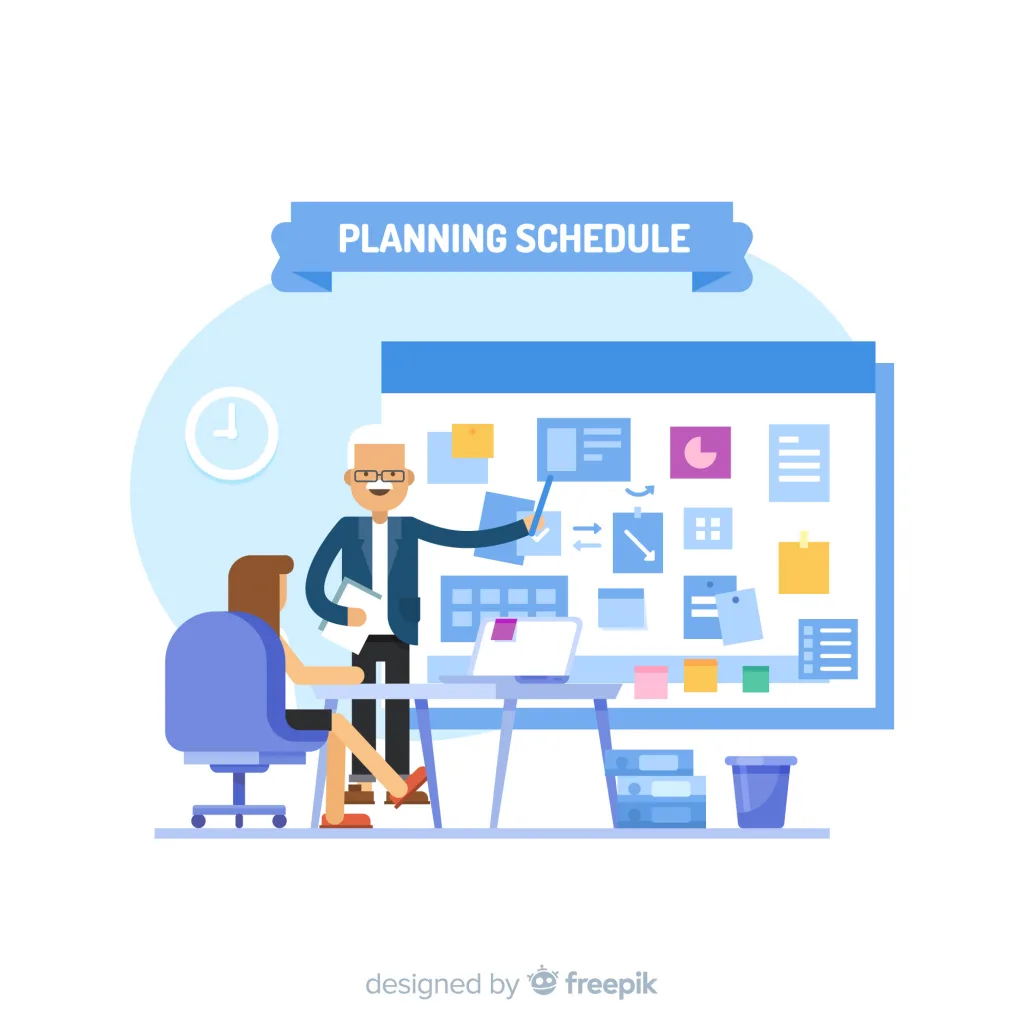Understanding the Concept of Scenario Planning
As the business landscape evolves and changes rapidly, strategic decision-making and future planning have become more crucial than ever. One effective approach to navigate uncertainty and manage potential risks is through scenario planning. In this post, we will delve into the concept of scenario planning, its definition, and how it can be used as a powerful tool for businesses to develop contingency strategies and future-proof their operations.
Disclosure: If you click on my affiliate/advertiser’s links, I am going to receive a tiny commission. AND… Most of the time, you will receive an offer of some kind. It’ s a Win/Win!
Scenario planning can be defined as a strategic foresight method that involves envisioning multiple plausible future scenarios based on different sets of assumptions. By exploring various possible outcomes, businesses can gain valuable insights into potential challenges and opportunities that may arise in the future.
The primary goal of scenario planning is not to predict the future with certainty but rather to enhance decision-making by considering a range of possible futures. It helps organizations identify potential risks, uncertainties, and disruptive factors that could impact their operations. By doing so, businesses can proactively develop strategies to mitigate risks and seize opportunities.

Image by Freepik
Here we will explore the key components of scenario planning, including how it helps in managing uncertainty, developing business contingency strategies, and ultimately ensuring long-term success in an ever-changing environment. We will also discuss real-world examples where scenario planning has been successfully implemented by organizations across different industries.
By understanding the concept of scenario planning and its practical applications, businesses can equip themselves with the tools necessary to navigate uncertainties effectively and make informed decisions that are aligned with their long-term goals. So, let’s dive into the world of scenario planning and discover its immense value in shaping a resilient and forward-thinking business strategy.
The Benefits of Scenario Planning in Business and Beyond
Scenario planning is a strategic foresight tool that has proven to be highly beneficial for businesses and organizations across various industries. By engaging in scenario planning, companies can effectively manage risks, gain a competitive advantage, and enhance their long-term planning capabilities.
One of the key benefits of scenario planning is its ability to help businesses identify potential risks and uncertainties in their operating environment. By considering multiple future scenarios, organizations can anticipate different outcomes and develop strategies to mitigate potential threats. This proactive approach to risk management enables companies to be better prepared for unexpected events and make informed decisions.
Furthermore, scenario planning allows businesses to gain a competitive advantage by exploring alternative futures and identifying potential opportunities. By analysing different scenarios, organizations can uncover new market trends, customer preferences, or technological advancements that may impact their industry. This insight enables them to adapt their business strategies accordingly and stay ahead of the competition.
Long-term planning is another area where scenario planning proves valuable. Traditional strategic plans often focus on a single forecasted future, which may not accurately reflect the complex dynamics of today’s rapidly changing business landscape. Scenario analysis helps businesses consider multiple plausible futures, enabling them to develop flexible strategies that can adapt as circumstances evolve.
Adaptive business planning is an essential aspect of scenario planning. As organizations face ever-increasing uncertainty and volatility in the global marketplace, they need agile approaches that allow them to respond quickly to changing conditions. Scenario planning encourages adaptive thinking by challenging assumptions and encouraging creative problem-solving.
In conclusion, scenario planning offers numerous benefits for businesses seeking effective risk management practices, competitive advantage, long-term strategic insights, and adaptive business planning capabilities. By embracing this approach, companies can navigate uncertainties with confidence while positioning themselves for success in a very much unpredictable world.

Photo by Kindel Media
Step-by-Step Guide to Conducting Effective Scenario Planning
Scenario planning is a strategic tool that helps organizations anticipate and prepare for the future by exploring different possible scenarios. By following a step-by-step guide, businesses can conduct effective scenario planning and make informed decisions to adapt to changing circumstances.
- Identifying key uncertainties: Identifying the critical factors that could significantly impact your business or situation.
- Crafting scenarios: Developing plausible and diverse future scenarios based on different combinations of uncertainties.
- Analysing scenarios: Assessing the implications and potential outcomes of each scenario on your business or situation.
- Making decisions: Using the insights gained from scenario analysis to inform strategic decisions and actions.
- Evaluating and adapting: Continuously monitoring and updating scenarios as new information emerges.
The first step in the scenario planning process is identifying key uncertainties. This involves identifying the factors or events that could have a significant impact on the organization’s future. These uncertainties can range from technological advancements to changes in consumer behaviour or economic conditions.
Once the key uncertainties are identified, the next step is crafting, or developing scenarios. Scenarios are plausible and alternative narratives of how the future might unfold based on different combinations of these uncertainties. It is important to create a range of scenarios that cover both optimistic and pessimistic outcomes.
After developing scenarios, the next step is evaluating their implications. This involves analysing each scenario to understand its potential impact on various aspects of the organization such as operations, finances, market share, and customer demand. This evaluation helps in identifying potential risks and opportunities associated with each scenario.
Analysing scenarios involves assessing their likelihood and plausibility based on available data and expert opinions. This step helps in prioritizing scenarios based on their probability of occurrence and potential impact.
Once all scenarios have been analysed, decision-makers can proceed with making decisions based on this analysis. The insights gained from scenario planning help in formulating strategies that are robust enough to withstand various future possibilities.
Lastly, organizations must be prepared to adapt as new information becomes available or circumstances change. Scenario planning is an ongoing process that requires continuous evaluation and monitoring and adjustment as new insights emerge.
By following this step-by-step guide to conducting effective scenario planning, businesses can enhance their ability to navigate uncertainty, make informed decisions, and proactively respond to changing environments.
Real-Life Examples of Successful Scenario Planning in Action
Real-life examples of successful scenario planning in action provide valuable insights into how businesses have effectively utilized this strategic tool. By examining business case studies and scenario planning success stories, we can gain a deeper understanding of the benefits and applications of this approach.
One industry that has seen notable success with scenario planning is the finance industry. Financial institutions often face complex and unpredictable market conditions, making scenario planning an essential tool for strategic decision-making. For instance, during the global financial crisis of 2008, banks that had implemented robust scenario planning were better equipped to navigate the turbulent economic landscape.
In one such example, a major investment bank used scenario planning to anticipate potential market disruptions and identify opportunities for growth. By considering various scenarios such as economic downturns or regulatory changes, they were able to develop contingency plans and adapt their strategies accordingly. This proactive approach helped them mitigate risks and maintain a competitive edge in an ever-changing financial landscape.
Another industry-specific example comes from the energy sector. With increasing concerns about climate change and shifting consumer preferences towards renewable energy sources, companies in this field have embraced scenario planning to navigate future uncertainties. By exploring different scenarios such as policy changes or advancements in technology, energy companies can strategically position themselves for long-term success.
One notable example in the energy sector is Royal Dutch Shell, which utilized scenario planning in the 1970s. They anticipated the oil crisis and adjusted their strategies accordingly, positioning themselves to weather the storm better than competitors.
A final example of utilising scenario planning successfully is IBM in the early 1990s. Facing challenges in the rapidly changing tech landscape, IBM employed scenario planning to navigate potential shifts. This proactive approach allowed them to transform and remain a key player in the industry.
These real-life examples highlight how businesses across industries have leveraged scenario planning to make informed decisions amidst uncertainty. Whether it’s anticipating market disruptions or adapting to changing consumer demands, scenario planning provides a framework for strategic thinking and enables organizations to stay ahead of the curve.
By studying these success stories and understanding how different industries have applied scenario planning techniques, businesses can gain valuable insights into its practical applications and tailor it to their specific needs.
The Role of Technology in Enhancing Scenario Planning Efforts
In today’s rapidly changing business landscape, scenario planning has become an essential tool for organizations to navigate uncertainty and make informed decisions. With the advancements in technology, particularly in the field of data analytics and predictive modelling, scenario planning efforts have been greatly enhanced.
Scenario planning software tools have emerged as valuable assets for organizations looking to conduct comprehensive scenario analysis. These tools enable businesses to create multiple scenarios based on different variables and assumptions, allowing them to explore various potential outcomes and their implications. By leveraging these software tools, organizations can simulate different scenarios and assess the impact of each one on their business strategies.
Data analytics plays a crucial role in enhancing scenario planning efforts by providing valuable insights into historical trends, market dynamics, customer behaviour, and other relevant factors. By analysing large volumes of data, organizations can identify patterns and trends that can inform their scenario planning exercises. This data-driven approach enables businesses to make more accurate predictions about future possibilities and better understand the potential risks and opportunities associated with each scenario.
Predictive modelling further enhances scenario planning by using statistical techniques to forecast future outcomes based on historical data. By building models that capture complex relationships between variables, organizations can simulate different scenarios and predict how they might unfold under various conditions. This allows decision-makers to evaluate the likelihood of specific outcomes occurring and develop strategies accordingly.
In summary, technology has revolutionized scenario planning efforts by providing powerful software tools for creating multiple scenarios, leveraging data analytics for deeper insights into market dynamics, and utilizing predictive modelling techniques for accurate forecasting. By embracing these technological advancements, organizations can enhance their strategic decision-making processes and effectively navigate uncertainties in today’s dynamic business environment.
Pitfalls to Avoid and Best Practices for Effective Scenario Planning Implementation
When it comes to implementing scenario planning, there are certain pitfalls that organizations should be aware of and best practices they can follow to ensure its effectiveness. By avoiding common mistakes and adopting the right strategies, businesses can engage stakeholders effectively and continuously monitor and adapt their scenarios for better decision-making.
One common mistake to avoid in scenario planning is a lack of stakeholder engagement. It is crucial to involve key stakeholders from different departments or areas of expertise throughout the process. This ensures a diverse range of perspectives and insights, leading to more robust scenarios.
Another pitfall is failing to continuously monitor and adapt scenarios as new information becomes available. Scenarios should not be static documents but rather dynamic tools that are regularly reviewed and updated. By keeping an eye on relevant trends, data, and external factors, organizations can make necessary adjustments to their scenarios in a timely manner.
To implement effective scenario planning, it is important to establish clear objectives from the outset. This helps guide the process and ensures that the scenarios developed align with the organization’s strategic goals. Additionally, organizations should invest in quality data collection and analysis techniques to inform their scenario development accurately.
Furthermore, effective communication plays a vital role in successful scenario planning implementation. Regularly sharing updates on progress, insights gained from scenarios, and potential implications with stakeholders fosters transparency and buy-in from all involved parties.
Lastly, organizations should encourage a culture of learning and experimentation when it comes to scenario planning. Embracing feedback loops allows for continuous improvement of the process over time.
By avoiding these pitfalls and following these best practices for effective scenario planning implementation – such as engaging stakeholders effectively, continuous monitoring, adaptation – businesses can harness this powerful tool for informed decision-making in an ever-changing business landscape.
The Limitations and Challenges of Scenario Planning
Scenario planning is a valuable tool for organizations to anticipate and prepare for future uncertainties. However, it is important to acknowledge the limitations and challenges that come with this approach. By understanding these factors, businesses can make more informed decisions and mitigate potential risks.
One of the primary limitations of scenario planning lies in cognitive biases. These biases can influence the way scenarios are developed, leading to an incomplete or skewed understanding of possible outcomes. It is crucial for planners to be aware of their own biases and actively seek diverse perspectives to ensure a comprehensive analysis.
Data limitations also pose a challenge in scenario planning. The availability and quality of data can vary, making it difficult to accurately predict future trends or events. Incomplete or outdated data may lead to flawed assumptions and unreliable scenarios. Planners must carefully assess the reliability of their data sources and consider alternative sources when necessary.
Another challenge is the tendency for over-reliance on assumptions in scenario planning. While assumptions are necessary for constructing scenarios, excessive reliance on them can lead to unrealistic or overly optimistic projections. Planners should continuously question and validate their assumptions through rigorous analysis and feedback loops.
Implementing scenario planning within an organization can also present challenges. It requires effective communication, collaboration, and coordination among various stakeholders who may have different perspectives or priorities. Additionally, integrating scenario planning into existing decision-making processes may require changes in organizational culture and mindset.
In conclusion, while scenario planning offers valuable insights into potential future scenarios, it is important to recognize its limitations and challenges. By addressing cognitive biases, data limitations, over-reliance on assumptions, and implementation challenges head-on, organizations can enhance the effectiveness of their scenario planning efforts and make more informed strategic decisions.
Conclusion: Harness the Power of Scenario Planning to Navigate Uncertainty with Confidence
In conclusion, harnessing the power of scenario planning can be a game-changer for businesses looking to navigate uncertainty with confidence. By incorporating business contingency strategies and adaptive planning techniques, organizations can effectively mitigate risks and future-proof their operations.
Strategic foresight methods, such as scenario planning, provide businesses with a structured approach to anticipate and prepare for various potential futures. This allows them to identify potential challenges and opportunities in advance, enabling proactive decision-making.
By considering multiple scenarios and their implications, businesses can develop robust strategies that are flexible enough to adapt to changing circumstances. This not only helps them survive unexpected disruptions but also positions them to thrive in an ever-evolving marketplace.
Moreover, scenario planning encourages cross-functional collaboration and knowledge sharing within an organization. It brings together different perspectives and expertise from various departments, fostering a holistic approach to strategic decision-making.



